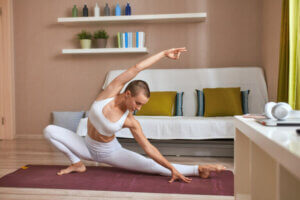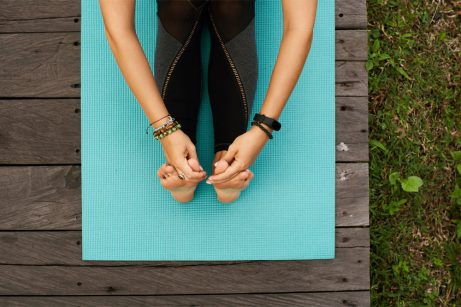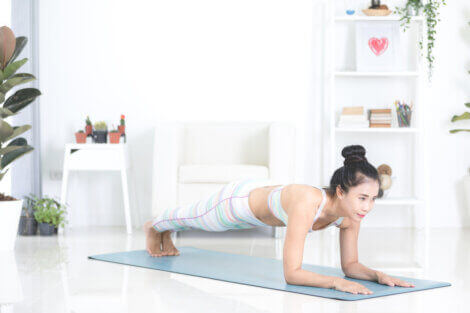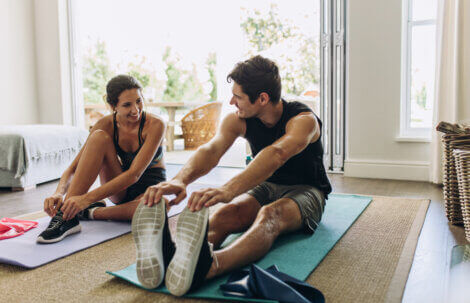Doing Yoga at Home - Setting up a Place

There’s often not enough time, and it can be hard to find ways to channel stress and deal with the daily bustle of life. This means you can’t practice the hobbies that you like. For this reason, we want to show you how to set up the perfect space for doing yoga at home.
Relaxation activities and sports help us to loosen up the muscles, oxygenate the mind, and improve rest. Why not do these activities at home instead of having to go out all the time?
Nowadays, there are different ways to carry out all kinds of exercise at home. The internet has plenty of information sources and videos. The only thing you need is to have a properly prepared and adapted place.
Choose the most suitable spaces for doing yoga at home

You can do yoga in pretty much any room as long as it’s big enough. In other words, small and narrow rooms are not ideal, as you may not feel comfortable and it will be impossible to do all the movements.
The first thing you have to do is take a look at all the rooms in your house and evaluate which you can use for this purpose. Some people use storage rooms, attics, or other unused rooms. While that’s a great idea, doing yoga in the living room or a bedroom is also an option.
You have two options to choose from: either transform a space and use it exclusively to do yoga, or use a place where you can set up all of the resources you’ll need every time you want to work out. Both options are valid, you just have to analyze the pros and cons of each one.
The fundamental goal is to feel comfortable and have enough space.
Doing yoga at home – adapting and setting up a place

Below, we’ll list some tips to correctly set up a room for doing yoga. Let’s look at the 4 steps to follow:
- You can turn a room that you don’t use into an exercise room. This doesn’t mean that you’ll be turning it into a gym with machines, you’ll just be transforming it into a suitable space to work out.
- Since yoga is an activity that is mostly done while lying on the ground, there has to be a comfortable floor. We recommend using several wooden pallets and some rubber tiles as well. It’s also a good idea to have an exercise mat for greater comfort.
- You’ll probably use the same room to do Pilates or cardio. Therefore, you should organize other resources that help to perform the exercises on shelves, drawers, and cabinets. Always put the storage containers against corners or attach them to the wall.
- Finally, it’s important to mention that access to natural light is an essential element of doing yoga. This allows you to achieve calmness, sensitivity, and relaxation.
Doing yoga at home – setting up a room

When adapting a room, always remember that it needs to be a large room. If this isn’t the case, it’s best to move the furniture away from the center of the room to feel like you have some extra space.
Wooden floors are undoubtedly the best option. If you’re going to buy an apartment, and you know that you’ll use a room to do yoga, make sure it has wooden floors. However, you’ll still need a small mat or pad.
As we mentioned above, natural light is very important. You probably have more than enough natural light in your living room, but if you want even more light, warm lights are a safe bet. This is because they convey security and spiritual calm.
Adapting a space is a simple process.
Adapting a bedroom

The bedroom is probably the most private room in your house. Many yoga teachers carry out their online classes in a designated room or the living room, but they do yoga in their bedroom. This gives them more privacy and feel in harmony with themselves.
It’s a good idea to have a section of your bedroom without any furniture to perform the exercises correctly. We recommend that you do it next to a window and use a mat or rug to protect the floor from wearing out.
There’s often not enough time, and it can be hard to find ways to channel stress and deal with the daily bustle of life. This means you can’t practice the hobbies that you like. For this reason, we want to show you how to set up the perfect space for doing yoga at home.
Relaxation activities and sports help us to loosen up the muscles, oxygenate the mind, and improve rest. Why not do these activities at home instead of having to go out all the time?
Nowadays, there are different ways to carry out all kinds of exercise at home. The internet has plenty of information sources and videos. The only thing you need is to have a properly prepared and adapted place.
Choose the most suitable spaces for doing yoga at home

You can do yoga in pretty much any room as long as it’s big enough. In other words, small and narrow rooms are not ideal, as you may not feel comfortable and it will be impossible to do all the movements.
The first thing you have to do is take a look at all the rooms in your house and evaluate which you can use for this purpose. Some people use storage rooms, attics, or other unused rooms. While that’s a great idea, doing yoga in the living room or a bedroom is also an option.
You have two options to choose from: either transform a space and use it exclusively to do yoga, or use a place where you can set up all of the resources you’ll need every time you want to work out. Both options are valid, you just have to analyze the pros and cons of each one.
The fundamental goal is to feel comfortable and have enough space.
Doing yoga at home – adapting and setting up a place

Below, we’ll list some tips to correctly set up a room for doing yoga. Let’s look at the 4 steps to follow:
- You can turn a room that you don’t use into an exercise room. This doesn’t mean that you’ll be turning it into a gym with machines, you’ll just be transforming it into a suitable space to work out.
- Since yoga is an activity that is mostly done while lying on the ground, there has to be a comfortable floor. We recommend using several wooden pallets and some rubber tiles as well. It’s also a good idea to have an exercise mat for greater comfort.
- You’ll probably use the same room to do Pilates or cardio. Therefore, you should organize other resources that help to perform the exercises on shelves, drawers, and cabinets. Always put the storage containers against corners or attach them to the wall.
- Finally, it’s important to mention that access to natural light is an essential element of doing yoga. This allows you to achieve calmness, sensitivity, and relaxation.
Doing yoga at home – setting up a room

When adapting a room, always remember that it needs to be a large room. If this isn’t the case, it’s best to move the furniture away from the center of the room to feel like you have some extra space.
Wooden floors are undoubtedly the best option. If you’re going to buy an apartment, and you know that you’ll use a room to do yoga, make sure it has wooden floors. However, you’ll still need a small mat or pad.
As we mentioned above, natural light is very important. You probably have more than enough natural light in your living room, but if you want even more light, warm lights are a safe bet. This is because they convey security and spiritual calm.
Adapting a space is a simple process.
Adapting a bedroom

The bedroom is probably the most private room in your house. Many yoga teachers carry out their online classes in a designated room or the living room, but they do yoga in their bedroom. This gives them more privacy and feel in harmony with themselves.
It’s a good idea to have a section of your bedroom without any furniture to perform the exercises correctly. We recommend that you do it next to a window and use a mat or rug to protect the floor from wearing out.
All cited sources were thoroughly reviewed by our team to ensure their quality, reliability, currency, and validity. The bibliography of this article was considered reliable and of academic or scientific accuracy.
- Jones, María; Pace, Adele: Cómo estar en forma: guía para personas muy ocupadas, Barcelona, Amat, 2001.







